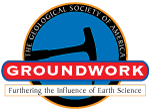Abstract View
Volume 25 Issue 11 (November 2015)
GSA Today
Article, pp. 34–35 | Full Text | PDF (120KB)
 |
| Search GoogleScholar for Search GSA Today |
GROUNDWORK:
We need to talk: Facilitating communication between field-based geoscience and cyberinfrastructure communities
1 Dept. of Geology, Sonoma State University, Rohnert Park, California 94928, USA
2 Dept. of Geology & Geophysics, The University of Utah, Salt Lake City, Utah 84112, USA
3 Information Sciences Institute, University of Southern California, Marina del Rey, California 90292, USA
4 Dept. of Applied Linguistics, University of California at Los Angeles, Los Angeles, California 90095, USA
5 Dept. of Psychology, Temple University, Philadelphia, Pennsylvania 19122, USA
6 Dept. of Geoscience, University of Wisconsin–Madison, Madison, Wisconsin 53706, USA
A Unique Opportunity for Cyberinfrastructure
It is increasingly important to integrate datasets and models from multiple geoscience subdisciplines in order to significantly advance our knowledge of how the planet works. To facilitate interdisciplinary investigations, geoscientists need a cyberinfrastructure that will easily access and combine datasets from all of the current and future geo-community databases. To this end, NSF introduced the EarthCube initiative (www.earthcube.org) to “create a community-driven data and knowledge management system that will allow for unprecedented data sharing across the geosciences.” The ultimate goal of EarthCube is to transform Earth science investigations by promoting efficient data access, incorporating cyberinfrastructure into our scientific workflow, and allowing for increased sophistication of analyses and models (Gil et al., 2014; Kelbert, 2014; Richard et al., 2014). A significant strength of EarthCube is its potential to create sustained communication across the subfields within the Earth sciences, allowing scientists to ask new types of questions, and providing the means to address previously unanswerable ones. Examples of specific use cases are available on the EarthCube webpage; however, using machine learning to extract data from published articles (e.g., DeepDive [http://deepdive.stanford.edu]) and curating useful software/scripts (e.g., GeoSoft [http://www.isi.edu/ikcap/geosoft/]) are two widely applicable examples of EarthCube outcomes.
Manuscript received 27 Feb. 2015; accepted 9 June 2015
doi: 10.1130/GSATG248GW.1
